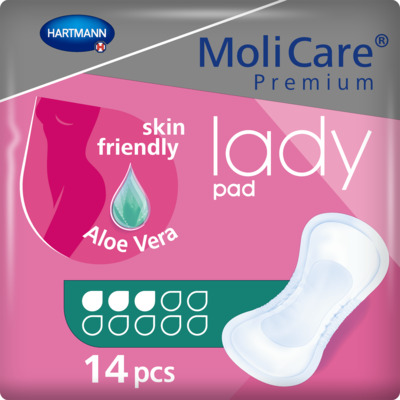Incontinence Advice
Symptoms of the Perimenopause
Perimenopause is the transitional phase before menopause begins. During perimenopause, your levels of oestrogen decrease and your periods become irregular. You might experience symptoms such as hot flashes, worsening premenstrual syndrome (PMS) and even urine leakage.1, 2

Perimenopause can last from a few months to several years. It ends and menopause begins when you go 12 months without a period.
What is perimenopause?
Perimenopause is the time from the start of your oestrogen levels decreasing to the definitive end of your periods. It can begin as early as your 30s or as late as your 50s and it can vary in length from a few months to a few years. But for the majority, it lasts four to eight years and begins in your 40s.1
During this transition, your ovaries begin producing lower levels of female hormones and stop releasing eggs. Periods become irregular and unpredictable. Perimenopause, therefore, is a sign of your fertility declining.1, 2
During perimenopause, your body is adjusting to different hormone levels, so you can experience some physical changes and symptoms.1, 2

Symptoms of perimenopause
The first sign of perimenopause is usually irregular or skipped periods. Other typical symptoms of perimenopause include:1, 2
- Worse premenstrual syndrome (PMS)
- Heavier or lighter periods than usual
- Hot flushes and night sweats
- Sleeping problems
- Vaginal dryness
- Mood changes
- Fatigue
- Lower sex drive
- Urine leakage, usually when coughing or sneezing.3
Perimenopause and incontinence
Urine leakage due to bladder weakness is a frequent symptom during perimenopause, affecting more than 50% of women 4.
This is because the female hormone that decreases during perimenopause – oestrogen – also has a role in the normal functioning
of the tissues related to urinary function, such as the urethra and pelvic floor muscles that support both your urethra and bladder.
As these tissues weaken, they are less able to work normally. As a consequence, women can experience symptoms including: 3
- Stress incontinence: losing of few drops of urine when coughing, sneezing, laughing, lifting something heavy
or doing other activities that put pressure on the bladder. In advanced stages, it may also occur when walking or
changing position from lying down to standing up. - Urge incontinence: the fast and unexpected need to pee. This is also called “irritable” or “overactive” bladder.
- Nocturia: the urge to pee several times in the middle of the night.
- Painful urination: a burning sensation while peeing that also can be caused by an infection,
so consult your doctor if you experience this.
Difficulties with bladder control: are they always related to perimenopause?
Hormonal changes during perimenopause are not the only cause of urine
leakage in middle-aged women. Some other factors can have a role too:3, 4
- Natural weakening of muscles due to age
- Pelvic floor injuries after giving birth
- Conditions such as diabetes, multiple sclerosis or Parkinson’s
disease
- The use of some medicines, such as antidepressants or painkillers
- Sedentary lifestyles and obesity.
How can I stop incontinence during perimenopause and menopause
Incontinence can be treated. Talk to your GP about your problems and concerns so you can find the most appropriate therapy together.
International Continence Society guidelines indicate that treatment of urinary incontinence should begin with conservative therapy, such as physiotherapy or pharmacotherapy. If needed, however, there are surgical treatments that can bring positive results.4 Nevertheless, your first step should be to try lifestyle changes that can help to prevent and control your urine leakage. Request your free copy of our MoliCare care pack.
Changes in habits
Lifestyle change is recommended for most patients regardless of the type or severity of their disease. Treatment for people with obesity should start with weight reduction. It is also important to limit the consumption of caffeine, alcohol or carbonated drinks.
Sports that adversely affect the pelvic floor, such as heavy weightlifting or running, should be avoided. But other sports may be recommended. For example, swimming is an excellent activity for taking care of your pelvic floor.
Pharmacotherapy
You can receive treatments, such as oestrogen or adrenergic medicines, that enhance the elasticity and strength of your bodily tissues and help maintain bladder function. In addition, anticholinergic drugs can reduce bladder hyperactivity.
Physiotherapy
Your specialised physiotherapist may recommend exercises with pessaries or other physical therapies as biofeedback. Reports indicate good outcomes in up to 80% of patients in the early stages of urinary incontinence. It is also a good idea for older women, pregnant women and new mothers to use pelvic floor exercises as a preventative measure.
Surgery
Surgical treatment should be introduced only after exhausting all of the possibilities of conservative therapies. There are different surgical methods available depending on the type and stage of urinary incontinence. Talk to your doctor about which is the most suitable treatment for your problem.
MoliCare by your side for urine leaks
Looking for a product for your incontinence, use MoliCare® Premium Lady Pads for light to moderate urinary leakage. Their anatomical shape provides a comfortable fit, while three layers of absorbent materials assure reliable protection and dryness.
The pad is also gentle on your skin due to its soft top layer and pH-neutral value. MoliCare Premium Lady Pads 5 Drops is also ideal for the day and night usage ensuring a reliable protection. In case of heavy urinary leakage, use MoliCare® Premium Mobile Pants 10 Drops, which adjust to your body under your clothes for up to 12 hours leakage protection and discretion. Choose the product that’s best for you by looking at the packaging: the higher the number of drops, the greater the absorption.
1 Perimenopause. Cleveland Clinic Health Library. https://my.clevelandclinic.org/health/diseases/21608-perimenopause
2Perimenopause Guide. WebMD https://www.webmd.com/menopause/guide/guide-perimenopause
3 Menopause and Bladder Control Management. Women Guide. WebMD https://www.webmd.com/urinary-incontinence-oab/womens-guide/bladder-control-menopause#1
4 Kolodynska G, Zalewski M, Rozek-Piechura K. Urinary incontinence in postmenopausal women – causes, symptoms, treatment. Menopause Rev 2019; 18(1): 46-50. https://pubmed.ncbi.nlm.nih.gov/31114458/
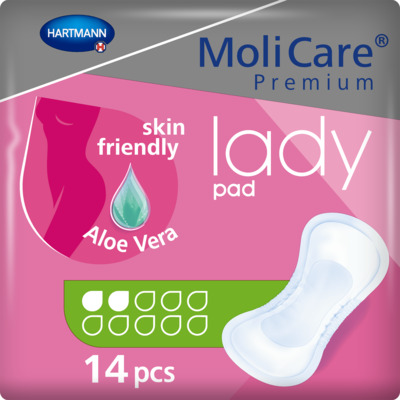
MoliCare® Premium Lady Pad 2 Drops
<h2>Skin Friendly Pant Liners</h2> <p>For women that experience slight incontinence and bladder weakness, across different age groups, it can be a challenge to find the right bladder weakness product that is easy to apply and wear without the worry of potential leakages. Fortunately, we understand this approach, hence why we are happy to offer our MoliCare® Premium Lady Pad 2 drops, that is skin-friendly, Aloe Vera applied, and comes with 14 liners per bag.</p> <h2>Slim and discreet liners</h2> <p>Whether dealing with stress incontinence or urge incontinence, these panty liners offer a discreet and easy solution on the go. Simply place the pad in your underwear and secure it with the adhesive strip for all-round protection. Available in different absorbency levels, MoliCare® bladder weakness products cater to all levels of bladder weakness, ensuring secure care.</p> <h2>Control Bladder Weakness</h2> <p>Enjoy the benefits of these body-shaped absorbent panty liners, designed for women with bladder weakness. The pads offer discreet, reliable protection with features including odour control and fast absorption.</p> <p>With a wide adhesive strip, you can comfortably fix the pad in your regular underwear, providing secure and comfortable fixation. The pads are skin-friendly, featuring soft, breathable materials, including foam cuffs, and a top sheet treated with Aloe Vera.</p> <p>Keeping your skin healthy is a priority, which is why MoliCare® Premium Lady Pads have a skin-neutral pH value of 5.5 and an antibacterial finish. They are also dermatologically tested, offering peace of mind.</p> <h2>Buy pant liners online</h2> <p>Never worry about running out with our convenient order service and fast delivery direct to your door. Enjoy free shipping on orders over £50.</p> <p>If you need assistance, our professional customer service team is here to support you in choosing the right product. Reach out to us today at 0800 028 9470 and experience the comfort and reliability of MoliCare® Premium Lady Pads.</p>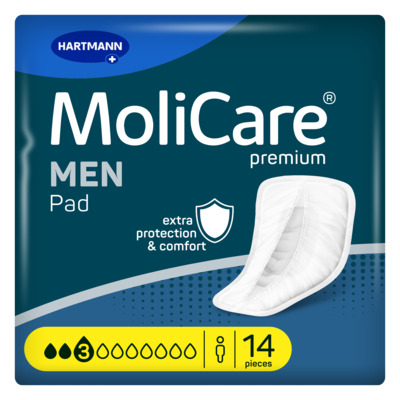
MoliCare® Premium Men Pad 3 Drops (ISO 441ml)
<p><strong>Reliable and discreet incontinence pads for men with an instant-dry feeling</strong></p> <p>Bladder weakness is difficult to live with, the last thing you want to worry about is incontinence protection. That’s why our best-ever MoliCare® premium MEN Pad 3 drops offer an <strong>all-round protection</strong> that keeps everything dry and comfortably in place while fitting discreetly in your regular underwear.</p> <p>The incontinence pad for men quickly <strong>removes urine from the surface up to 86 %* faster than before</strong> and neutralises unpleasant odours to leave you feeling instantly dry and in control thanks to the new <strong>MoliCare SkinGuard</strong>®<strong> Absorbent Core Technology</strong>. This skin-friendly technology not only helps you feel up to 90 %* drier than previous MoliCare® premium<strong> </strong>MEN pads, it also helps to maintain healthy skin and preventing irritation.</p> <p><strong>Engineered for the male anatomy</strong> and dermatologically tested for maximum skin compatibility, these male urinary pads do not contain colour, perfume or latex making them environmentally friendly too.</p> <p>*Compared to last generation</p>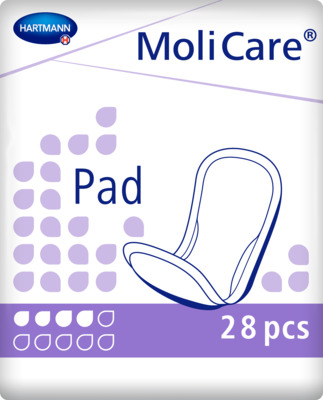
MoliCare® Pad 4 Drops
<h2>Handy MoliCare incontinence pads to carry on the go</h2> <p>Our MoliCare® Pad 4 Drops are an essential product for those experiencing slight incontinence, allowing you to regain control and live your busy and active life without the interference of bladder weakness. Designed for both men and women, this incontinence pad for men and women offers exceptional dryness and protection, ensuring your comfort and confidence.</p> <h2>‘Barely There’ Reassurance and Reliability</h2> <p>The MoliCare® Pad 4 Drops are slimline, discreet, and adjusted to fit your body seamlessly. It fixes securely inside your underwear, providing a ‘barely there’ comfort feel. With its soft and skin-kind fabric, along with a wide adhesive fixing strip on the backsheet, you can go about your day with the assurance of being protected against leakages.</p> <p>The absorbent core effectively prevents your skin from becoming too moist, while the elastic anti-leak edging adds an extra layer of security and peace of mind. Say goodbye to any worries about odours, as the MoliCare® Pad 4 Drops also neutralises odours to keep you fresh and confident throughout the day. Don't let incontinence hold you back from living life to the fullest.</p> <p>Ordering your MoliCare® Pad 4 Drops is hassle-free, as we offer fast delivery direct to your door. With our price match promise, you can trust that you're getting the best value for your money. Plus, enjoy free delivery on all orders over £50.</p> <p>If you need assistance in finding the perfect incontinence product for your needs, our friendly customer care team is here to help. Don't hesitate to reach out to us at 0800 028 9470. Take control of your life with the reliable protection and comfort of the MoliCare® Pad, alongside other <a href="https://www.hartmanndirect.co.uk/incontinence-products/incontinence-pads" style="color:#0563c1; text-decoration:underline">incontinence pads</a>.</p>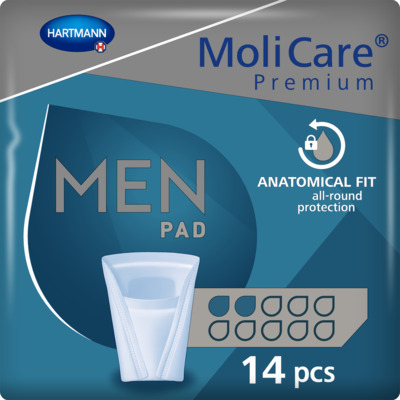
MoliCare® Premium Men Pad 2 Drops
<h2>Superior Comfort and Protection for men</h2> <p>This product is part of our mens range of incontinence pads and pouches for men handling slight incontinence. </p> <p>It is a one size fits all with the MoliCare® Premium Men Pad 2 drops, designed to keep the skin fresh and dry. The anatomical fit of the pad allows for all-round protection. These specially designed pads offer superior comfort, security, and protection, allowing men to confidently carry on with their daily activities without worries.</p> <p>Still unsure whether to choose this product? Check out these additional features:<br /> </p> <ol> <li>Tailored for Men: MoliCare® Premium Men Pad 2 Drops is specifically designed to cater to the unique anatomy and needs of men experiencing bladder weakness. The pouch shape and comfortable fit ensure maximum coverage and security.</li> <li>Reliable Absorption: The pouch's absorbent core quickly and effectively locks away moisture, keeping the skin dry and preventing any discomfort or irritation.</li> <li>Odour Control: With built-in odour neutralisers, MoliCare® Premium Men Pad 2 Drops helps to maintain a fresh and odour-free environment, boosting confidence and ensuring discretion.</li> <li>Soft and Gentle: The soft topsheet is gentle on the skin, promoting skin health and preventing any irritation or chafing.</li> <li>Discreet and Thin Design: These pads are slim and discreet, allowing men to wear them under regular underwear without any bulkiness or discomfort.</li> <li>Ideal for Light Bladder Weakness: Whether it's occasional leaks or mild incontinence, these pads provide reliable protection, giving men the confidence they need to face each day with ease.</li> <li>Discreet Packaging: The pads are individually wrapped for convenience and discretion, making them easy to carry and use discreetly when needed.</li> </ol>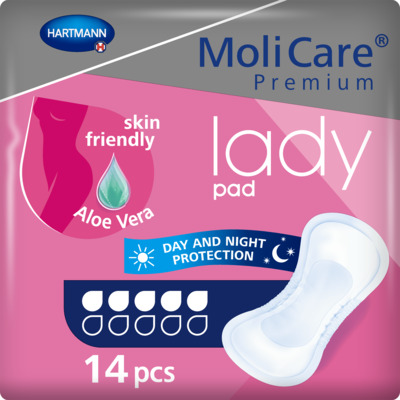
MoliCare® Premium Lady Pad 5 Drops
<h2>Choose what's right for you</h2> <p>This product range is the epitome of quality and comfort. All women of different ages, shapes and sizes, will experience incontinence differently, and for those that have to deal with moderate incontinence daily, the premium lady pad 5 drops is the option for you.</p> <h2>Stay Comfortable with MoliCare®</h2> <p>The Premium Lady Pad 5 Drops comes in a discreet and slim design, ensuring a secure and comfortable fit inside your regular underwear. With a wide adhesive strip, you can move freely without worrying about the pad moving.</p> <p>Experience the benefits of the fast-absorbing core, which efficiently locks away moisture and prevents leaks even during those moments of intense activity.</p> <p>Our skin-friendly approach ensures your comfort and well-being, with a soft topsheet treated with Aloe Vera, pH-balanced, and dermatologically tested.</p> <h2>Quick delivery</h2> <p>Stay fresh and odour-free on the go, thanks to the added odour neutraliser that seals away any unwanted smells. The MoliCare® Premium Lady Pad 5 Drops is the ultimate solution for women seeking maximum protection and comfort during moderate bladder weakness days. Embrace confidence and ease with these pads, tailored to cater to your specific needs. With MoliCare®, you can continue living an active and fulfilling life without limitations.</p> <p>With this information in mind, be sure to order your MoliCare® Premium Lady Pad 5 drops today. Many ladies, like yourself, may be dealing with bladder weakness, and are relying on HARTMANN Direct to deliver the goods! Be sure to do the same and make sure that you remain happy and comfortable, knowing that your incontinence needs are taken care of. Order online now, and you will receive your items within 2-3 working days.</p>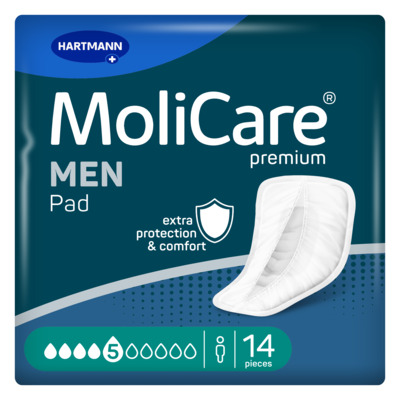
MoliCare® premium MEN Pad 5 drops (ISO 906ml)
<p><strong>Instant-dry feeling with premium incontinence pads for men</strong></p> <p>Take control over bladder weakness with the new and improved MoliCare® premium MEN Pad 5 drops.</p> <p>Designed to comfortably sit in normal underwear, these dermatologically tested incontinence pads are <strong>engineered specially for the male anatomy and deliver protection against moderate bladder control issues</strong>. Feel comfortable and secure thanks to the pad’s unique anti-leakage system.</p> <p>The new <strong>MoliCare SkinGuard</strong>®<strong> Absorbent Core Technology</strong> ensures urine is absorbed up to 86 %* faster from the surface for that instant-dry feeling that leaves your skin feeling up to 90 %* drier the moment you need it. The skin-friendly protection layer helps to maintain the skin’s pH balance to <strong>prevent skin irritation in the intimate area</strong>. Plus, the absorbent core helps control unpleasant odours to keep you comfortable and fresh. These male urinary pads do not contain colour, perfume or latex making them environmentally friendly too. </p> <p>*Compared to last generation</p>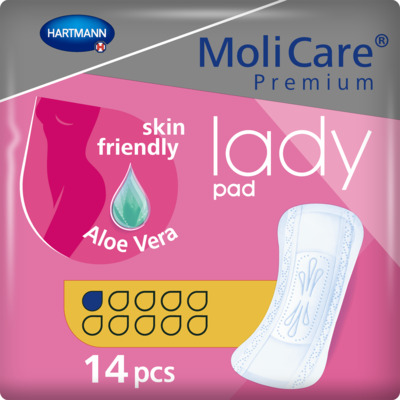
MoliCare® Premium Lady Pad 1 Drop
<h2>Feel fresh and confident on the go</h2> <p>The pant liner is small and lightweight, so it's easy to carry with you on the go. And the odour neutraliser helps to keep you feeling fresh and confident all day long.</p> <p>If you're looking for a reliable panty liner that will help you stay dry and comfortable, the MoliCare® Premium Lady Pad is a great option.</p> <h2>Control Bladder Weakness</h2> <p>Bladder weakness in women can be caused by an overactive bladder or a weak pelvic floor. MoliCare® Premium Lady Pads are designed to help women manage bladder leakage. These pant liners are discreet and comfortable, and they provide all-round protection against leaks.</p> <p>The pant liners are body-shaped and absorbent, and they are designed for women with very light bladder weakness. They are also skin-friendly, thanks to the soft, breathable materials and the Aloe Vera-treated top sheet. The pant liners are also pH-balanced and antibacterial, which helps to keep your skin healthy.</p> <h2>Slim and discreet liners</h2> <p>MoliCare® Premium Lady Pads are available in great value 14-piece packs. They are slimline and discreet, so you can wear them with confidence. And, with our reliable order service, you never have to worry about running out.</p> <h2>Reliable delivery </h2> <p>We also offer a fast delivery service, direct to your door. And, for all orders over £50, we offer free shipping too! Further benefits of ordering from us includes a secure transactional payment.</p> <p>If you need more help, our professional, friendly customer service team is on hand to advise and support you in choosing the right product. Call us today on 0800 028 9470.</p>